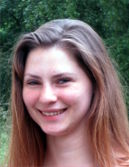Sanah Altenburg
 PhD student
PhD student
Room: B-111
Phone: +49 271 740 3536
Preprints
See also arxiv
Sanah Altenburg, Michał Oszmaniec, Sabine Wölk, and Otfried Gühne
Estimation of gradients in quantum metrology  arXiv:
1703.09123
arXiv:
1703.09123
We develop a general theory to estimate magnetic field gradients in quantum metrology. We consider a system of N particles distributed on a line whose internal degrees of freedom interact with a magnetic field. Classically, gradient estimation is based on precise measurements of the magnetic field at two different locations, performed with two independent groups of particles. This approach, however, is sensitive to fluctuations of the off-set field determining the level-splitting of the ions and therefore suffers from collective dephasing, so we concentrate on states which are insensitive to these fluctuations. States from the decoherence-free subspace (DFS) allow to measure the gradient directly, without estimating the magnetic field. We use the framework of quantum metrology to assess the maximal accuracy of the precision of gradient estimation. We find that states from the DFS achieve the highest measurement sensitivity, as quantified by the quantum Fisher information and find measurements saturating the quantum Cramér-Rao bound.
Publications
Sanah Altenburg, Sabine Wölk, Geza Toth, Otfried Gühne
Optimized parameter estimation in the presence of collective phase noise Phys. Rev. A 94,
052306
(2016),
arXiv:
1607.05160
Phys. Rev. A 94,
052306
(2016),
arXiv:
1607.05160
We investigate phase and frequency estimation with different measurement strategies under the effect of collective phase noise. First, we consider the standard linear estimation scheme and present an experimentally realisable optimization of the initial probe states by collective rotations. We identify the optimal rotation angle for different measurement times. Second, we show that sub-shot noise sensitivity - up to the Heisenberg limit - can be reached in presence of collective phase noise by using differential interferometry, where one part of the system is used to monitor the noise. For this, not only GHZ states but also symmetric Dicke states are suitable. We investigate the optimal splitting for a general symmetric Dicke state at both inputs and discuss possible experimental realisations of differential interferometry.
S. Albrecht, S. Altenburg, C. Siegel, N. Herschbach, G. Birkl
A laser system for the spectroscopy of highly charged bismuth ions Applied Physics B 107,
1069-1074
(2012),
arXiv:1108.5137
Applied Physics B 107,
1069-1074
(2012),
arXiv:1108.5137
We present and characterize a laser system for the spectroscopy on highly-charged ^209Bi^82+ ions at a wavelength of 243.87 nm. For absolute frequency stabilization, the laser system is locked to a near-infra-red laser stabilized to a rubidium transition line using a transfer cavity based locking scheme. Tuning of the output frequency with high precision is achieved via a tunable rf offset lock. A sample-and-hold technique gives an extended tuning range of several THz in the UV. This scheme is universally applicable to the stabilization of laser systems at wavelengths not directly accessible to atomic or molecular resonances. We determine the frequency accuracy of the laser system using Doppler-free absorption spectroscopy of Te_2 vapour at 488 nm. Scaled to the target wavelength of 244 nm, we achieve a frequency uncertainty of \sigma_{244nm} = 6.14 MHz (one standard deviation) over six days of operation.

